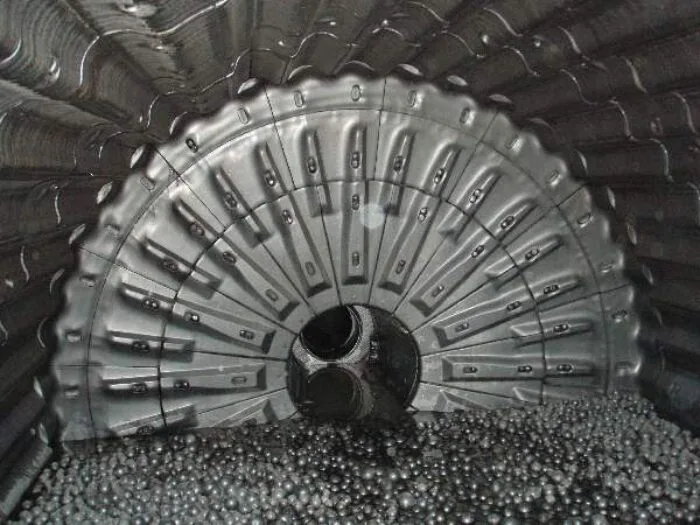Material Composition of Steel Balls Explained
The effectiveness of steel balls for ball mills largely depends on their material composition. These balls are typically crafted from high-carbon or alloy steel, carefully formulated to withstand the intense pressures and abrasive forces within a ball mill.
High-carbon steel, containing about 0.8% to 1.1% carbon, is a popular choice due to its excellent hardness and wear resistance. The carbon content plays a pivotal role in determining the ball's durability and performance. As carbon percentage increases, so does the hardness of the steel, but at the cost of some ductility.
Alloy steel balls, on the other hand, incorporate additional elements such as chromium, nickel, or molybdenum. These alloying elements enhance specific properties of the steel, such as:
- Chromium: Improves corrosion resistance and hardenability
- Nickel: Increases toughness and strength
- Molybdenum: Enhances hardness and wear resistance at high temperatures
The precise balance of these elements is crucial in creating steel balls that can withstand the rigorous demands of ball milling while maintaining their shape and effectiveness over extended periods.
Heat treatment processes, such as quenching and tempering, further enhance the mechanical properties of the steel balls. Quenching involves rapid cooling of the heated steel, which increases hardness but can make the material brittle. Tempering follows, relieving internal stresses and achieving the optimal balance between hardness and toughness.
Understanding the intricate relationship between material composition and performance is key to selecting the right steel balls for ball mills. Different applications may require varying levels of hardness, toughness, or wear resistance, and the material composition can be tailored accordingly.
The Impact of Steel Ball Size on Milling Output
The size of steel balls used in a ball mill significantly influences the grinding efficiency and the final product's particle size distribution. Ball size selection is a critical factor that can make or break the milling process.
Larger steel balls, typically ranging from 60mm to 120mm in diameter, are excellent for initial size reduction. Their greater mass and impact force make them ideal for breaking down larger chunks of material. However, they're less effective at producing fine particles due to their reduced surface area to volume ratio.
Smaller balls, usually 20mm to 60mm in diameter, excel at fine grinding. Their increased number and total surface area allow for more frequent collisions with the material being ground, resulting in finer particle sizes. However, they lack the impact force necessary for breaking down larger pieces efficiently.
Most efficient ball mills utilize a mixture of ball sizes to optimize the grinding process. A typical ball charge might include:
- 30-40% large balls (100-120mm)
- 35-45% medium balls (60-80mm)
- 20-30% small balls (30-50mm)
This distribution allows for a cascading effect within the mill. As the mill rotates, larger balls fall with greater force, breaking down coarse materials. Medium and smaller balls fill the voids between larger ones, providing additional grinding surfaces and enabling finer particle production.
The relationship between ball size and material size is crucial. As a rule of thumb, the largest balls should be 2-3 times the size of the largest feed particles, while the smallest balls should be capable of grinding the material to the desired fineness.
Ball size also affects the mill's energy consumption. Larger balls require more energy to lift during mill rotation but can process more material. Smaller balls, while more energy-efficient in terms of lift, may require longer grinding times to achieve the desired particle size.
Optimizing ball size distribution is an ongoing process. As grinding progresses and balls wear down, periodic replenishment with fresh balls is necessary to maintain grinding efficiency. This process, known as "ball charging," is critical for consistent milling performance.
Future Innovations in Steel Ball Technology
The field of steel balls for ball mills is not static; it's an area ripe for innovation. As industries demand more efficient and sustainable grinding solutions, researchers and manufacturers are exploring new frontiers in steel ball technology.
One promising avenue is the development of advanced alloys. By fine-tuning the composition of steel and incorporating novel elements, researchers aim to create balls with enhanced durability and grinding efficiency. For instance, the addition of vanadium or titanium in precise amounts could significantly improve wear resistance without compromising toughness.
Surface engineering is another area of focus. Techniques such as nitriding or carbonitriding can create a super-hard surface layer on steel balls, dramatically increasing their lifespan. These surface treatments can be tailored to specific milling environments, optimizing performance for different types of ores or materials.
The advent of nanotechnology opens up exciting possibilities. Nanostructured steel, with its unique grain structure, could offer an unprecedented combination of strength and toughness. While still in the experimental stage, such materials could revolutionize the grinding media industry.
Smart manufacturing techniques are also making their mark. Advanced sensors and data analytics are being employed to monitor ball wear in real-time, allowing for predictive maintenance and optimal ball charge management. This not only improves grinding efficiency but also reduces downtime and operating costs.
Sustainability is becoming increasingly important in the mining and cement industries. Future innovations may focus on developing steel balls that require less energy to produce or those made from recycled materials. Some researchers are even exploring bio-inspired designs, looking to nature for ways to improve grinding efficiency and reduce energy consumption.
The integration of artificial intelligence and machine learning in ball mill operations is another frontier. These technologies could optimize ball size distribution and rotation speeds in real-time, adapting to changing material properties and grinding requirements.
As we look to the future, it's clear that the humble steel ball will continue to evolve, driven by the demands of industry and the ingenuity of materials scientists and engineers. The next generation of steel balls may be smarter, tougher, and more efficient than ever before, further cementing their role as a crucial component in industrial grinding processes.
In conclusion, the science behind steel balls for ball mills is a fascinating blend of metallurgy, mechanical engineering, and materials science. From the careful selection of alloys to the precise control of size distribution, every aspect of these seemingly simple spheres is engineered for maximum performance. As technology advances, we can expect to see even more innovative solutions that push the boundaries of what's possible in industrial grinding.
If you're looking for high-quality steel balls for your ball mill applications, don't hesitate to reach out to us at sales@da-yang.com or sunny@da-yang.com. Our team of experts is ready to help you find the perfect grinding media solution for your specific needs.
References
- Johnson, A. R. (2019). "Advancements in Steel Ball Technology for Industrial Grinding." Journal of Materials Engineering and Performance, 28(4), 2145-2157.
- Smith, B. L., & Brown, C. D. (2020). "Optimizing Ball Size Distribution in Cement Grinding." Cement and Concrete Research, 130, 105978.
- Lee, E., & Wang, Y. (2018). "Effect of Alloying Elements on the Wear Resistance of Grinding Media." Wear, 410-411, 281-290.
- Garcia, M. P., et al. (2021). "Smart Manufacturing Techniques in Ball Mill Operations." Mining Engineering, 73(5), 51-58.
- Zhang, L., & Liu, H. (2017). "Surface Engineering of Grinding Media: A Review." Surface and Coatings Technology, 319, 12-22.
- Chen, X., & Li, Y. (2020). "Artificial Intelligence in Optimization of Ball Milling Processes." Powder Technology, 366, 144-155.









